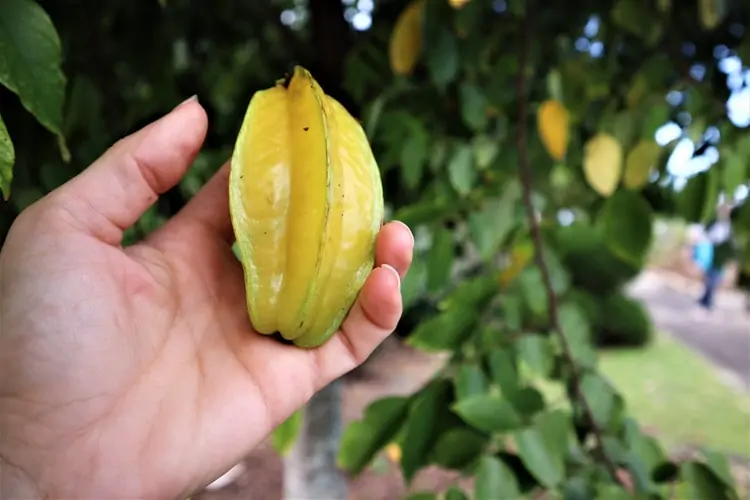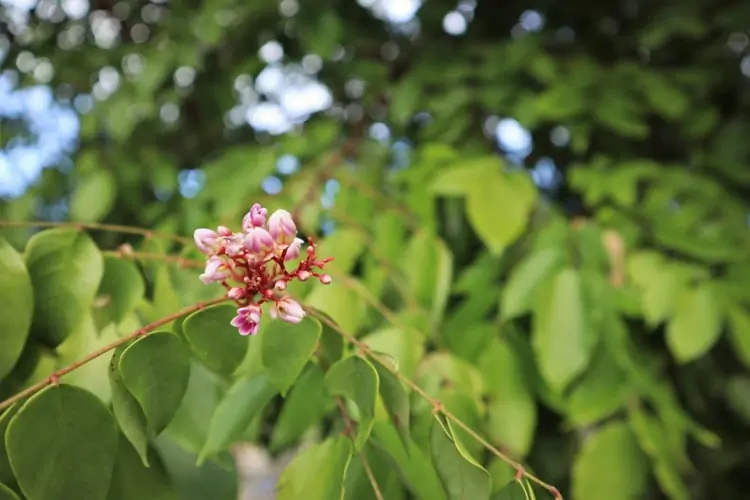by Amanda Rose Newton
Due to its unique star shape, Carambola has become more commonplace in the grocery store in recent years. When cut, the pinwheel-esque slices look beautiful in fruit salads, on skewers, and as the perfect garnish for your tropical cocktail.

Unfortunately, the fruit you often grab at the grocery store does not have a flavor that matches the cool aesthetic of the shape. I was certainly in that boat until I tasted fresh-from-the-tree star fruit which was bursting with an almost jolly rancher-like sweet flavor.
With tropical fruit month still going strong here at Rockledge Gardens, now is the time to give star fruit a second chance, especially if you have never experienced the delight of a homegrown variety!
If you have been on team star fruit for a while, you are probably aware that the trees grow beautifully here, pending they are planted in the right location. Reaching only about 20-30 feet in height, they are adaptable to a wide variety of landscapes.
Aside from producing a gorgeous canopy with red-tinged leaflets and pink flowers, carambolas tend to fruit multiple times (spring and fall) during the year, providing a source for beautiful fruit salads for multiple seasons. Carambola is so much more than just a garnish!
Varieties of Carambola
The best varieties of star fruit to grow in your Florida landscape:
Arkin: The most common variety found in Florida, produces an orange fruit that is sweet and crunchy.
Golden Star: Mildly sweet and decorative, and performs well in our alkaline soil.
Kari: This heavy producer features a sweet flavor enjoyed by most.
Sri Kambangum: Similar to Arkin with a gold color and slightly sweeter taste.
Maher Dwarf: Reaching only 6 ft tall, this is a great fruit tree for containers. The fruit is sweet-tart.
Planting Your Star Fruit Tree
Whatever variety you choose, all carambolas prefer at least 5 hours of direct sun a day in order to set fruit.

When planting, be sure to plant the tree no deeper than the root ball and mix half the soil from your yard with a nicely amended planting mix. We always recommend adding Espoma biotone to encourage root growth. Native to Southeast Asia, star fruit prefers life on the moister side, so pay special attention to it during periods of drought.
Once planted, they require little more from you than perhaps a little bit of nourishment in the form of Maxicrop liquid seaweed or Citrus Nutritional Spray during the cooler months. Remember, carambola is a tropical tree, so it is not unusual for them to drop leaves during the winter.
The fruit takes about 60 days to fully ripen and are best left to do so on the tree to ensure the sweetest taste. To avoid thievery from small mammals and birds (and maybe a neighbor or two), you can wrap paper bags around developing fruit.
Starfruit Popsicles
If you are looking for a summertime fun way to celebrate with star fruit, putting both the flavor and the shape on display in a frozen treat cannot be beat!
Ingredients:
6 starfruit plus 1 sliced for garnish
1/3 cup water
¼ cup lemon or lime juice
1/3 cup sugar, stevia, or substitute
2 tbs agave nectar, maple syrup, or honey
Popsicle mold (or paper cups and wooden craft sticks)
Method:
1. Cut starfruit flesh into small pieces
2. Blend fruit with water and citrus juice until smooth
3. Using cheesecloth or a sieve, strain juice from pulp over a bowl. Use a spoon to push as much juice as possible through cloth. 1 ¾ cup of juice is needed for the mold.
4. Cook starfruit juice with sugar and agave over medium heat until sugar dissolves. Let cool.
5. Place a slice of starfruit from reserved fruit in each mold (or cup)
6. Pour mixture over fruit into each mold and insert sticks.
7. Freeze for 6 hours.


